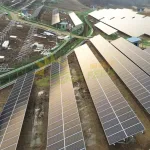
Solarvest Aims to Pave the Path to Carbon Neutral Future
June 5, 2024
Sun on the Sand: Middle East and North Africa (MENA) Turns to Solar Power
June 5, 2024sep 24, 2020 EST
The University of Queensland (UQ) in Australia has laid claim to a renewable energy first. Not just first in the state of Queensland, or the nation of Australia—but reportedly first in the world. Since the opening of the US$90 million (AU$ 125 million) 64MW Warwick Solar Farm, UQ is held to be the first major university in the world to draw all the power required for its daily operations from renewable energy sources alone.
This project is a fantastic achievement for this institution, and a further illustration of the immense potential that exists for universities to be leaders in the growth of solar energy generally. Especially as although UQ’s achievement is outstanding in its own right, there are also numerous other educational institutions that have made solid inroads in this space, and collectively serve to showcase the rich diversity of possibilities on offer in this arena for other universities looking to commit to a substantial solar project.
More Solar in the Sunshine State
The northeastern Australian state of Queensland is seen as a very promising destination for growing Australia’s solar capacity. As a state with a landmass of 1.853 million km², there are of course many variables from one length of its border to the next. Yet the fact its capital city Brisbane—located around just 100kms from Queensland’s southernmost border and only around 70kms from the Gold Coast, the state’s second-biggest city—regularly ranks among the sunniest capital cities in Australia illustrates the potential for solar to boom among the state capital and many other regions in the years ahead.
What’s more, recent years have seen Queensland enjoying robust growth in its population and economy. Like essentially every other jurisdiction in the world, the impact of coronavirus has stalled this temporarily, but there’s every expectation the state will see a return to this enviable economic form in years ahead. Meanwhile, as of July this year, it’s held the state now has 6,600MW of large-scale renewable generation that is already operational or committed.
Grading the Work
The Warwick Solar Farm is actually two separate but identical solar plants residing on the same (adjacent) site. Each farm has the capacity for a power transfer capability of 32.1MW, and is connected to a 33kV network at the Warwick Bulk Supply Point substation, with the expectation it shall generate around 160,000 MWh per annum—estimated to be sufficient to power 27,000 homes.
Although by no measure is US$90 million small change, the cost-efficiency aspects of the farm are also tremendous. Any excess energy that the farm generates will be sold into the National Electricity Market. Because of the sheer size of Warwick, it is expected this excess energy will aid in putting downward pressure on wholesale energy prices. Ensuring the benefits of Warwick’s operations extend far beyond UQ’s grid activity alone.
Local Project, Global Impact
For then-UQ Vice-Chancellor and President Professor Peter Høj AC,this projectshowed UQ leadership across the Australian and global education community.
This isn’t just an economic choice; industry and government look to us for expertise and leadership in renewable technologies and this asset will support a wide range of current and emerging research and industry partnerships across a broad array of disciplines. The generation profile of the solar farm provides an ideal opportunity for piloting emerging battery energy storage or hydrogen conversion technologies.
—said Vice-Chancellor Høj.
In turn, that “it will keep our teaching and research at the forefront of the booming renewables industries, aided by the University’s own large operational investments into sustainable engineering technologies over the past decade or more.”
“When it comes to climate change, we all share the responsibility and the consequences, and so we need to be acting in a way that is informed by research and with collaboration in mind”, said Vice-Chancellor Høj.
“With solar technology becoming increasingly affordable in the past decade, the economics of solar photovoltaic power are increasingly compelling and we look forward to developing collaborations with industry partners who wish to pilot and prove innovative new energy solutions.”
An Assessment of Other Universities
Just as UQ’s Warwick Farm is a wonderful achievement, it does join many other recent additions to the global solar network by universities in Australia and around the world.
Further south along the Australian mainland in Victoria, the University of Melbourne notably installed 388 frameless solar panels upon its heritage-listed Wilson Hall, a building first built in 1853. As a result, Wilson Hall today has a thoroughly modern touch to it that brings a new energy to its rich history by virtue of the 100.88kW system.
In the United Kingdom, the University of Sussex is proud to have an 825kW system that stretches across 27 buildings of its campus. The system first switched on in 2017 has been a key part of the University’s longstanding strategy to halve its carbon emissions by 2020, and in turn, has been expected to consistently generate 750,000kWh from one year to the next
Finally, at Brazil’s UFPR University there is clear-cut evidence that not all projects need to be grand to be good. Their 1,165.6-kWp solar installation atop a carport may not have the same splendor or heritage as Melbourne University’s Wilson Hall, but is expected to save the University BRL$1.5 million a year on its annual costs. In an era where many universities around the world have come under new and complex financial pressures, the opportunity to obtain such savings is invaluable.
There has also been an impressive diversity seen behind the creation of solar installations across educational institutions generally. For while many are ultimately commenced and funded by the university (sometimes in partnership with the government), occasionally a project arises via a novel source. Northwestern University in the United States got its first solar project implemented in 2011 thanks to students raising US$117,000 to fund a 16.8-kilowatt panel display which generates around 20,000 kWh each year.




